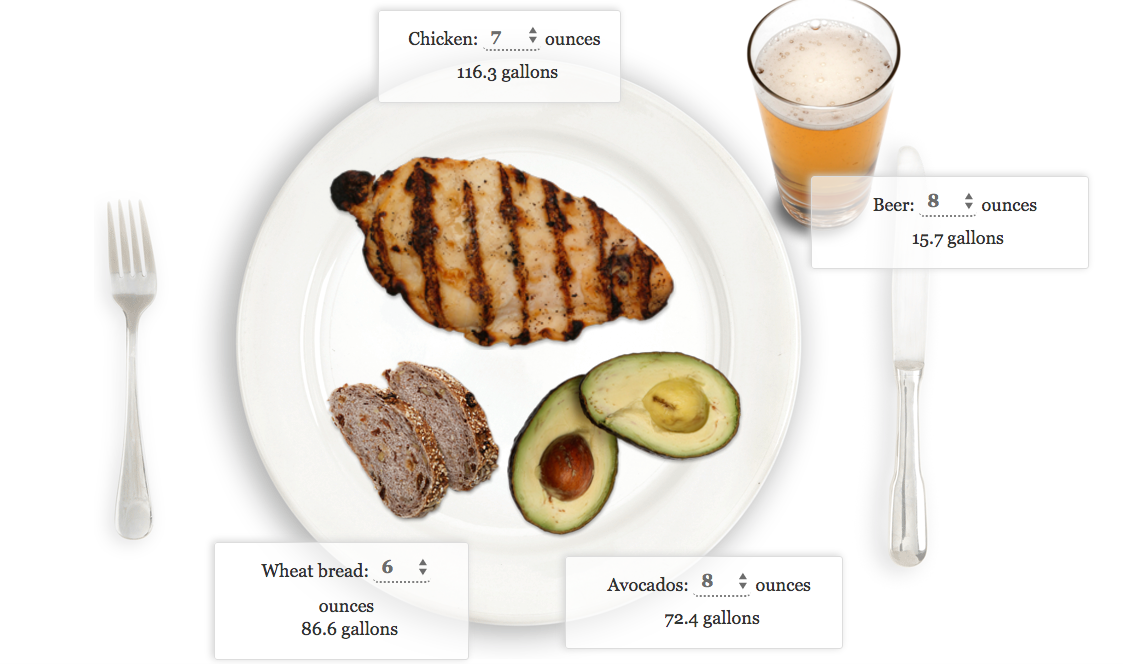
What It Takes to Produce One Ton of Chicken. There are essentially three ways chicken products are marketed ranging from raw commodity at the lowest end to fully-cooked value-added products on the high end.

72 decrease in farm land used in poultry production.
How much water is used to produce chicken. Actual production and use of the wheat flour uses 80 of the water. Water is needed for the chicken to drink and to maintain the chicken house and for growing the grains that the. The world population requires about 120 billion cubic meters of water per year in order to be able to.
How much water does it take to produce 1kg of chicken. 10 litres of water to produce a sheet of A4 paper 30 litres of water to produce a cup of tea 50 litres of water to produce an orange 70 litres of water to produce an apple 75 litres of water to produce 250ml of beer 140 litres of water to. In the US to produce one pound 1 lb 04kg of steak requires on average 1799 gallons of water for pork it is 576 gallons of water and for a pound of chicken it is 468 gallons of water.
Johns Hopkins University says that in general the ratios for water use are approximately 71 for beef 51 for pork and 251 for poultry. Chicken 8 oz 330 gallons Hamburger 4 oz 616 gallons Steak 8 oz 1232 gallons Where did the figures come from. In September 1991 the Water Education Foundation published a special report called Water Inputs in California Food Production by Marcia Kreith at UC Davis.
Chocolate tops the list with 17196 litres of water need to produce 1kg of the product. Beef sheep and pork meat all require high volumes of water for production also. This Is How Much Water It Takes To Make Your Favorite Foods Tea vs.
Tea is the winner at 108 gallons of water per gallon of brewed tea. Coffee requires almost 10. Beer at 296 gallons of water per gallon of beer.
It takes 872 gallons of water to produce. To understand the diversity of todays US poultry slaughter plants and highlight the need to evaluate water use beyond the traditional gpb unit of measure the 2010 WATT PoultryUSA survey results for the nations top five broiler-producing states ie. Georgia Arkansas Alabama Mississippi and North Carolina representing 55 per cent of US production were analysed.
From a resource-use point of view 1 l of green water consumption is equivalent to one litre of blue water consumption but the impact of a green WF on the environment is generally much smaller than the impact of a blue WF. Many factors have contributed to the reduced environmental impact of producing chicken including. 75 fewer resources required in poultry production.
36 reduced impact of poultry production on greenhouse gas emissions. 72 decrease in farm land used in poultry production. 58 decrease in water used in poultry production.
Today a chicken more than twice that size can be grown in less than half the time with only 11 pounds of feed. Chicken is the most efficient of the meat proteins in feed conversion. There are essentially three ways chicken products are marketed ranging from raw commodity at the lowest end to fully-cooked value-added products on the high end.
Global animal production requires about 2422 Gm 3 of water per year 872 green 62 blue 66 grey water. One third of this volume is for the beef cattle sector. Another 19 for the dairy cattle sector.
Most of the total volume of water 98 refers to the water footprint of the feed for the animals. More than a third of a pound 0335 was water in the pad. So 187 percent of what we bought was water you throw away before cooking.
Next watery was our supermarket value chicken. Meat Requires the Most Water A pound of chicken takes 518 gallons of water to produce. A pound of pork requires 718 gallons of water.
What It Takes to Produce One Ton of Chicken. Free-range birds use way way more energy than conventionally raised poultry. It takes over 20 times more water to produce 1kg of beef compared to rice grains beans fruit and vegetables in Australia.
It takes 800 litres of water to produce one litre of cows milk four times as much as it takes to make one litre of soy milk. Vegan households use less than a third of the water of the average Australian household. That translates to 7000 liters of water for steak dinner.
Check out how much water is needed to produce your meal in the list provided below by the United Nations for World Water Day. Cereal 1 cup 130 liters. Orange Juice 1 cup 170 L.
Coffee 1 cup 140 L.